



Do you ever think about being a tourist in your own home town?
I say this because sometimes it does not take much to have an interesting time where one lives, if one only takes the time to potter around one’s own patch. Annually or once a year, Muriel and I take time out of busy our schedules, Muriel from promoting Gracious Living through our retail experience at ‘Chez Nous’ and I from my museum in a shed, to re-discover where we live.
For us it is Glasgow, often referred to as “the Second City of the Empire.” Its tentacles reach out across the world with the possible exception of Edinburgh, which is the well behaved sister in the east, looking over its tweedy shoulder at the wild child of the west. Sometimes it seems Glasgow is the child who always lets the side down when the relatives come to call, but the one for whom you have a sneaking regard. Glasgow is the full fried breakfast with both link and flat sausage whereas Edinburgh is a plate of porridge with extra salt for lip pursing. There is no denying Edinburgh’s stark, cold beauty, but on the other hand Glasgow is where a stranger will give you his last sixpence. If you don’t believe me then try it and see.
Muriel calls our forays into the city our “Gay days in Glasgow” as she is always one for attempting to make a silk purse out of a sow’s ear. Mrs Travers (our daily woman what does, but not a lot) would simply braise a sow’s ear with onions for four hours.
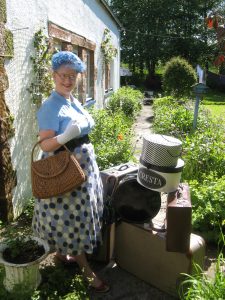
Sometimes we even start our trip from our rural bolt hole to add extra excitement, even although we of course also have our full town house in the exclusive West End. There is nothing quite like arriving at Glasgow Central Station and putting up at The Central Hotel rather than going home – especially when Mrs Travers and Grace (who is from the Caribbean and does the heavy work in addition to being distantly related, but more of that later) are vinegar washing the skirting boards and warm rabbit bran-ing Muriel’s fur coats. The second best ones that is, the best go to Karter’s for cold storage. July is also peak moth hunting season for Mrs Travers and things can get pretty unsavoury. The sole of her built up sandal becomes a site of such carnage that it is known as Culloden. So all in all delaying ones return home can be a blessing.
Central Station is very busy. It is a place for commuters from Ayr and Bridge of Weir and those on the run from Paisley. It‘s also a place of many stories – the place where twice this century young men have said goodbye to their wives, family and sweethearts, some never to return. Young men and women meet under the clock or at “the shell” and the wooden framed departure boards which are constantly put up and taken down manually are mesmerising.
All have a story perhaps great joy at a reunion after service abroad or great sadness at being the pregnant unmarried daughter, thrown out of the family home and met with once a week at the “Ladies” with a change of clothes and further admonition.
Definite Articles and an Entrance with Luggage
The Central Hotel (and do remember every name in Glasgow is preceded by the definite article as in The Rogano restaurant or The Locarno ballroom) is accessed from the concourse or more selectively from the entrance in Gordon Street. Muriel always uses the Gordon Street entrance, which has its own one way system to keep the traffic moving for vehicles approaching the hotel.
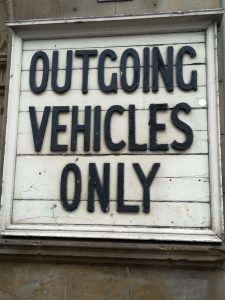
My nephew Sebastian, the thespian, is just like his aunt and says “nothing makes an impact like a good entrance”. I am quite happy to sneak in a little side entrance, but Muriel says this is for the staff and those who “might have done us a favour and stayed at home.”
In any case Muriel’s luggage is usually so mountainous that most side entrances would not cope. It is not necessarily the case (or cases!) that Muriel needs all her luggage and indeed one or two portmanteaux are known to contain little more than a curling stone wrapped in corrugated paper and a blanket. These are just used for “creating an impression” and are usually consigned to the care of the concierge. As Muriel says “luggage speaks” and “insufficient luggage says nothing.”

Muriel likes a room that looks in the direction of Glasgow Cathedral, the only drawback being that it is over the glass roof of the station and Muriel can her the station announcements many of which “display poor diction , too many consonants and not enough vowels.” The station master, who having been alerted to the arrival of Mrs Wylie, waits for the expected arrival of a note on a silver tray and to show willing puts his Aunt Phyllis on the tannoy for a couple of hours as she is from Milngavie and can enunciate with the best of them. Unfortunately this is rather one in the eye for the regular announcer, rasping Rachel from Ruchill with her dulcet tones honed by 60 a day Capstan full strength habit.
While Muriel unpacks with the aid of “housekeeping”, I usually repair to the Half Moon Bar for a bit of a stiffner after the journey and then we go downstairs to the Malmaison for suppa. Here one might easily bump into a visiting film star or even royalty. Gene Kelly has stayed here along with Mae West, Cary Grant and so, famously, has Roy Rogers and his horse Trigger. Muriel told the manager that if she found any signs of hay in her bed there would be trouble.
Sometimes we go dancing in the Locarno Club where Muriel is known for her Cha-Cha-Cha and we still cut something of a dash with our tango. This always makes a good outing on one’s wedding anniversary and I can honestly say we can still gancho with the best of them.
Sometimes after breakfast we just decide to wander around the city centre and take things as we find them. I of course am always looking for material for a lecture at the Hysterical or ideas for Museum in a Shed. One is naturally drawn to Glasgow buildings and it pays to look closely- although be careful or you might get run over by a trolley bus or a tram. Some of you may recall that fate befell Lady Pentland-Firth’s criminally insane suitor who was divided into three by the Auchenshuggle tram (limited stop).
Most of Gordon Street is taken up by The Central Hotel, but if you are thirsty then my nephew recommends The Corn Exchange Bar, which he often popped into on his way to play readings in Novar Drive or before going to see Dorothy Squires at The Pavilion.
If your interests are diverse then where Gordon Street meets Buchannan Street can be a good place to go separate ways until luncheon. On occasion, therefore, Muriel will turn right towards Wylie and Lochhead (distant cousins) to look at furnishings and MacDonald’s for something new to wear. I go left as you might expect.
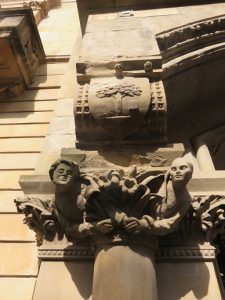
You might note some of the stone carving on a building to your left which has among other things the coat of arms of the City featuring the bird that never flew, the tree that never grew, the bell that never rang, and the fish that never swam. You will also see some art nouveau detail.
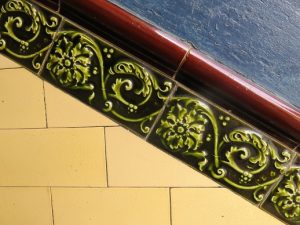
Glasgow loves its art nouveau which can also be seen it in the tiles of many of the closes. Staying on the same side, brings you to St Vincent Street where the banks are and the Anchor Buildings, headquarters of the shipping line. Look to your right and you will see the City Chambers, symbol of the greatness of Glasgow’s civic pride, but also the place where Churchill sent troops in January 1919 to deal with socialist unrest.
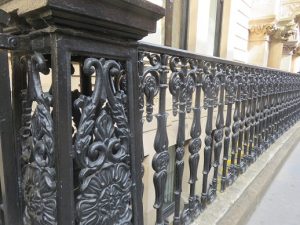
If you cross the road you come to some elegant railings. Glasgow is full of elegant iron railings, many of which were made by the city’s Saracen Foundry. They also exported their products all over the world, thus for example you can see one of their band stands in Pretoria Zoo.
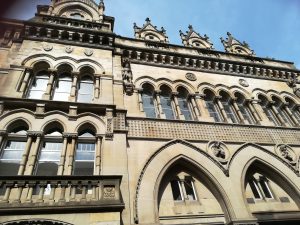
Looking upwards you will see the Stock Exchange with its carved heads representing the arts, science, commerce and industry. It was designed in the Venetian Gothic style by John Burnet in the 1870s. Glaswegians like the Venetian style it makes them think they are Italian merchant princes and many of their wives drink Campari and Soda . I have a rather nice etching, in my collection, of this building.
In the Square ahead of you – St George’s Place – is St George’s Tron Church with its lovely steeple. It is a Georgian Church built in 1808. It has had a number of famous ministers including Thomas Chalmers who would become leader of the famous Scottish “Disruption” in the 1840s. The Church of Scotland is prone to disruptions. This occurs when members of the congregation in “a fit of the sturdies” usually about some scriptural point walk out and set up another church. This is usually grimmer than the one they left. It is, however, very good for the building trade, church furnishers and stained glass manufacturers. It is, however, confusing for everyone else.
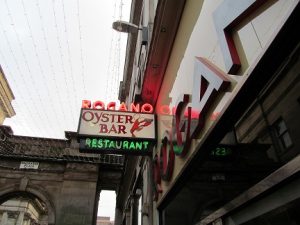
Lunchtime is never confusing , at least for me. Of course one cannot do much better than The Rogano in Exchange Square. Sometimes, however, I like to go to Sloan’s in the Argyle Arcade. The Rogano specialises in fish in sauce. Muriel is very fond of this restaurant as she likes the Art Deco interior which reminds her of the ship, the Queen Mary. Sloan’s is famous for its fish – and chips!
When Sebastian lived in Glasgow he preferred “something meatier” such as steak pie at the Waterloo pub in Wellington Street. A lot of his thespian friends meet here to do the sort of things thespians do.
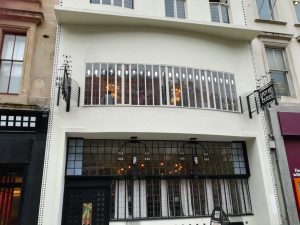
If you have had a substantial breakfast then you can always save yourself for afternoon tea at The Willow Tea Rooms inside Daly’s Department Store in Sauchiehall Street.
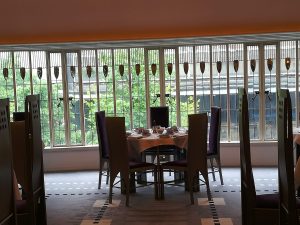
This was one of Miss Cranston’s famous tearooms designed by Charles Rennie Mackintosh –the architect, not the maker of Muriel’s squares.

Miss Cranston was very keen on tea and temperance as well as out of date fashions, although I am not sure Mr Mackintosh was. I mean of course he liked a swally, not crinoline dresses or at least as far as I know. Perhaps he was more of a bustle man! He was, however, a genius as was his wife Margaret who designed some beautiful panels.
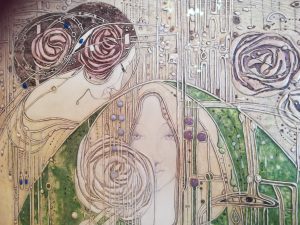
There were, as Muriel says, many very clever woman artists in Glasgow many favouring the art nouveau style, most of them forgotten.
An interesting alternative is to head west and have lunch in Byres Road. This you reach by taking the Subway (the Glasgow version of the Tube) to Hillhead where you also have the opportunity to visit the Art Galleries and Museum at Kelvingrove if you fancy a little walk. You might also consider visiting the very good varsity which was designed by George Gilbert Scott and is where Professor Sir Boozy Hawkes teaches in the music department where he is also a specialist in many things particularly Bach.
Muriel gets rather annoyed with me because to be frank I find Bach a bit heavy going, which she says is a reflection of my inability to cope with mathematics beyond the odds at Kempton Park. To be accepted in polite Glasgow society, one has to be au fait with Bach. Apparently one has to remember that with Bach it is “the phrasing” which is “marvellous” and even more important are “the silences”. It seems “too many people ignore the silences” and Professor Sir Boozy Hawkes is trying to get them reinstated.
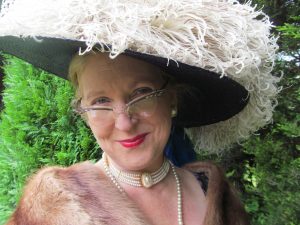
Muriel and Lady Pentland-Firth are fully behind it and are planning a very fashionable concert of silences.
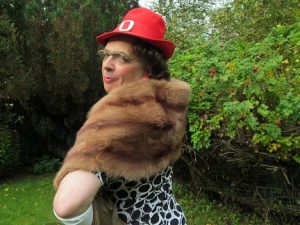
I have to confess to being slightly puzzled by this as silence is not one of Lady Pentland-Firth’s notable attributes and as for Muriel, I have never noticed a vacuum she has not managed to fill. A bit like Glasgow perhaps? It is with its shipyards and engineering, hardly ever silent and perhaps that influences its people who tend to have opinions on most things to which they give voice. It can be harsh, but often tempered with humanity coming out of adversity- which you will discover if you are ever in a taxi queue at Central Station after closing time. Just remember if someone in the queue suggests you sing “You are my sunshine “ it’s best not to be shy or standoffish.
Toodlepip
Jasper Wylie
July 1959